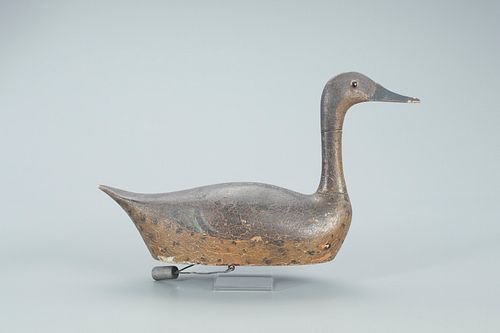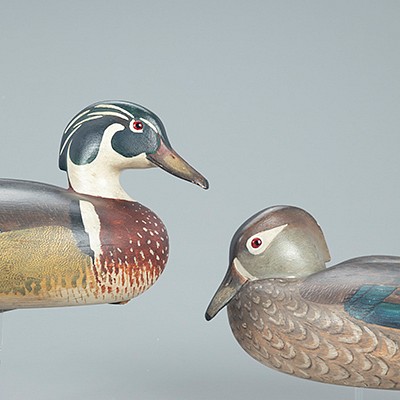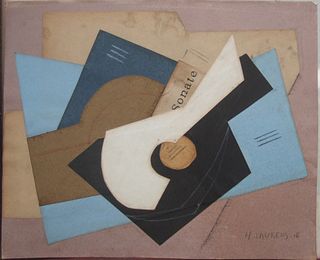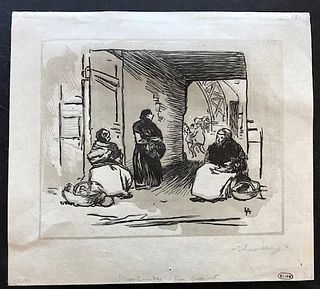The Trinosky Family Kankakee Pintail Hen Decoy, Herman R. Trinosky (1874-1956) Rig
About Seller
20 Winter Street
Pembroke, MA 02359
United States
Founded in 2005, Copley Fine Art Auctions is a boutique auction house specializing in antique decoys and American, sporting, and wildlife paintings. Over the course of the last two decades, the firm has set auction records for not only individual decoy makers, but also entire carving regions. Copley...Read more
Two ways to bid:
- Leave a max absentee bid and the platform will bid on your behalf up to your maximum bid during the live auction.
- Bid live during the auction and your bids will be submitted real-time to the auctioneer.
Bid Increments
| Price | Bid Increment |
|---|---|
| $0 | $50 |
| $1,000 | $100 |
| $2,500 | $250 |
| $5,000 | $500 |
| $10,000 | $1,000 |
| $25,000 | $2,500 |
| $50,000 | $5,000 |
About Auction
Mar 4, 2022
Lots 1-264 Copley Fine Art Auctions cinnie@copleyart.com
- Lot Description
The Trinosky Family Kankakee Pintail Hen
Herman R. Trinosky (1874-1956) Rig
Kankakee Marsh, IN, c. 1895
17 in. long and 10 in. tall
"These highest of high heads by a masterful but unidentified hand capture the essence of the pintail by exaggerating the species' thin, elongated form. The decoys were used on the Grand Kankakee Marsh in Indiana, which originally covered more than 500,000 acres in northwestern Indiana and northeastern Illinois and ranked among the great freshwater wetland ecosystems and hunting grounds of the world before much of it was drained for agricultural use." — Robert Shaw, "Bird Decoys of North America," 2010, discussing four rigmates
Well over a decade has passed since the Kankakee pintails first appeared. Their discovery is considered by most to be the greatest material decoy find of the twenty-first century. Within three years, a total of just seven of these high-head pintails were collected, consisting of three drakes and four hens. Those seven exceptional birds quickly found their way into the nation’s top decoy and Americana collections and into two books, including landing on the front cover of one.
Information on the rig has trickled out slowly. In 2010 Robert Shaw illustrated four birds in his “Bird Decoys of North America,” in which he reported that seven were found in a house in Indiana. Later, Herman Trinosky’s name came up as the rig owner, and probable maker, of these Kankakee pintails. In 2019 it was reported that a hen “...was in the original burlap bag given as a gift from Trinosky to the family that helped him clean out his barn.”
In 2021, the eighth Kankakee pintail was revealed by a member of the Trinosky family. That Trinosky Family Kankakee pintail drake set a world record for the rig at its auction debut in the recent Sporting Sale 2021.
Set aside decades or even a century ago, this superb hen was also selected by Trinosky to keep in the family, where it has been preserved for four generations. This Trinosky Family Hen has been consigned by a direct descendant of Herman Trinosky and a close relative of the drake’s consignor. This hen represents the ninth, and likely final, Kankakee pintail known to exist.
Throughout history, decoy carvers often amended or altogether discarded their early patterns in favor of sturdier utilitarian designs. A perfect example of this evolution is Henry Keyes Chadwick (1865-1958) of Martha’s Vineyard, whose earliest redheads started out with stylish thin necks, long bodies, and thin, sharp paddle tails. Later, he modified his designs to have shorter bodies and thicker necks, thus acknowledging the utility flaws of his first carving period. With limited output and easily broken heads and tails, few of these intact redheads exist today. These early “flawed” designs, however, are the ones most coveted by collectors today. While no examples of middle-period or late-period Kankakee pintails are known to exist, more conventional and less fragile examples of mallards and bluebills from the rig attest to the maker’s more practical side.
Defined by its elegant form, this decoy showcases long and sweeping lines. The bird’s refined head features subtle cheek carving and a stylish bill that tapers with crisp edges. The graceful neck is fully extended and slightly drawn back, forming a S-curve through the sweeping breast. This neck treatment is accurate for the species, yet almost unseen in other surviving decoys. The body exhibits a smooth humped back that tapers to a long and thin uplifted tail. Viewed from above, the tail reveals a two-stage taper. This special tail treatment, along with the tall height, and its original glass eyes distinguish it from its rigmates.
The bird’s complete condition is remarkable given its design, which was prone to breakage while being hunted and transported. The form, paint, patina, and unaltered condition of this new discovery place the Trinosky Family Kankakee Pintail Hen at the apex of this iconic rig.
In untouched condition, this hen remains in original paint with gunning wear, including some flaking mostly to left side and breast. Old paint drip on lower left side. Neck is loose at base and has a crack at its mid-section.
Provenance: Herman Trinosky Rig
Private Collection, by descent in the family from the above
Literature: Robert Shaw, "Bird Decoys of North America," New York, NY, 2010, p. 39, rigmates illustrated and discussed. Gene and Linda Kangas, "Great Lakes Interpretations," Concord, OH, 2011, front cover and, p. 182, rigmates illustrated. Gene and Linda Kangas with Ron Gard, "Kankakee Marsh Pintails: The Magnificent Seven," from "Hunting and Fishing Collectibles Magazine," Lawsonville, NC, July-August 2009, pp. 16-26, rigmates illustrated. Christie's, "Important American Furniture, Folk Art, Silver, Prints and Decoys," New York, NY, January 18-19, 2007, lot 365, rigmates illustrated. Guyette & Deeter Inc., "North American Decoys at Auction," July 2019, lots 139 and 140, burlap storage of rigmate discussed. Copley Fine Art Auctions, “The Sporting Sale 2021,” Hingham, MA, July 10-11 2021, lot 112, the Trinosky Family Pintail Drake illustrated.Please email condition report requests to colin@copleyart.com. Any condition statement given is a courtesy to customers, Copley will not be held responsible for any errors or omissions. The absence of a condition statement does not imply that the lot is in perfect condition.Condition
- Shipping Info
-
Copley Fine Art Auctions does not handle the shipping of any items. Shipping is the sole responsibility of the buyer. Once your payment has cleared, and we have received your authorized shipping release form items may be released for shipment. Copley Fine Art Auctions, LLC shall have no liability for any loss or damage to such items. Buyers should allow up to four weeks for shipment.
-



 EUR
EUR CAD
CAD AUD
AUD GBP
GBP MXN
MXN HKD
HKD CNY
CNY MYR
MYR SEK
SEK SGD
SGD CHF
CHF THB
THB














